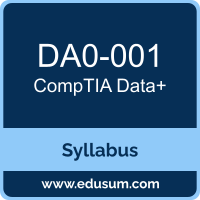 Use this quick start guide to collect all the information about CompTIA Data+ (DA0-001) Certification exam. This study guide provides a list of objectives and resources that will help you prepare for items on the DA0-001 CompTIA Data+ exam. The Sample Questions will help you identify the type and difficulty level of the questions and the Practice Exams will make you familiar with the format and environment of an exam. You should refer this guide carefully before attempting your actual CompTIA Data Plus certification exam.
Use this quick start guide to collect all the information about CompTIA Data+ (DA0-001) Certification exam. This study guide provides a list of objectives and resources that will help you prepare for items on the DA0-001 CompTIA Data+ exam. The Sample Questions will help you identify the type and difficulty level of the questions and the Practice Exams will make you familiar with the format and environment of an exam. You should refer this guide carefully before attempting your actual CompTIA Data Plus certification exam.
The CompTIA Data+ certification is mainly targeted to those candidates who want to build their career in Data Certification, domain. The CompTIA Data+ exam verifies that the candidate possesses the fundamental knowledge and proven skills in the area of CompTIA Data Plus.
CompTIA Data+ Exam Summary:
| Exam Name | CompTIA Data+ |
| Exam Code | DA0-001 |
| Exam Price | $255 (USD) |
| Duration | 90 mins |
| Number of Questions | 90 |
| Passing Score | 675 (on a scale of 100-900) |
| Books / Training | CompTIA CertMaster Learn |
| Schedule Exam | Pearson VUE |
| Sample Questions | CompTIA Data+ Sample Questions |
| Practice Exam | CompTIA DA0-001 Certification Practice Exam |
CompTIA DA0-001 Exam Syllabus Topics:
| Topic | Details |
|---|---|
Data Concepts and Environments - 15% |
|
| Identify basic concepts of data schemas and dimensions. |
- Databases
- Data mart/data warehousing/data lake
- Schema concepts
- Slowly changing dimensions
|
| Compare and contrast different data types. |
- Date - Numeric - Alphanumeric - Currency - Text - Discrete vs. continuous - Categorical/dimension - Images - Audio - Video |
| Compare and contrast common data structures and file formats. |
- Structures
- Data file formats
|
Data Mining - 25% |
|
| Explain data acquisition concepts. |
- Integration
- Data collection methods
|
| Identify common reasons for cleansing and profiling datasets. |
- Duplicate data - Redundant data - Missing values - Invalid data - Non-parametric data - Data outliers - Specification mismatch - Data type validation |
| Given a scenario, execute data manipulation techniques. |
- Recoding data
- Derived variables |
| Explain common techniques for data manipulation and query optimization. |
- Data manipulation
- Query optimization
|
Data Analysis - 23% |
|
| Given a scenario, apply the appropriate descriptive statistical methods. |
- Measures of central tendency
- Measures of dispersion
- Frequencies/percentages |
| Explain the purpose of inferential statistical methods. |
- t-tests - Z-score - p-values - Chi-squared - Hypothesis testing
- Simple linear regression |
| Summarize types of analysis and key analysis techniques. |
- Process to determine type of analysis
- Type of analysis
|
| Identify common data analytics tools. |
- Structured Query Language (SQL) - Python - Microsoft Excel - R - Rapid mining - IBM Cognos - IBM SPSS Modeler - IBM SPSS - SAS - Tableau - Power BI - Qlik - MicroStrategy - BusinessObjects - Apex - Dataroma - Domo - AWS QuickSight - Stata - Minitab |
Visualization - 23% |
|
| Given a scenario, translate business requirements to form a report. |
- Data content - Filtering - Views - Date range - Frequency - Audience for report
|
| Given a scenario, use appropriate design components for reports and dashboards. |
- Report cover page
- Design elements
- Documentation elements
|
| Given a scenario, use appropriate methods for dashboard development. |
- Dashboard considerations
- Development process
- Delivery considerations
|
| Given a scenario, apply the appropriate type of visualization. |
- Line chart - Pie chart - Bubble chart - Scatter plot - Bar chart - Histogram - Waterfall - Heat map - Geographic map - Tree map - Stacked chart - Infographic - Word cloud |
| Compare and contrast types of reports. |
- Static vs. dynamic reports
- Ad-hoc/one-time report
- Tactical/research report |
Data Governance, Quality, and Controls - 14% |
|
| Summarize important data governance concepts. |
- Access requirements
- Security requirements
- Storage environment requirements
- Use requirements
- Entity relationship requirements
- Data classification
- Jurisdiction requirements
- Data breach reporting
|
| Given a scenario, apply data quality control concepts. |
- Circumstances to check for quality
- Automated validation
- Data quality dimensions
- Data quality rule and metrics
- Methods to validate quality
|
| Explain master data management (MDM) concepts. |
- Processes
- Circumstances for MDM
|
To ensure success in CompTIA Data Plus certification exam, we recommend authorized training course, practice test and hands-on experience to prepare for CompTIA Data+ (DA0-001) exam.
